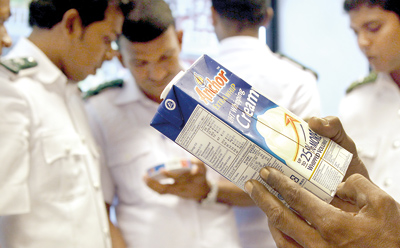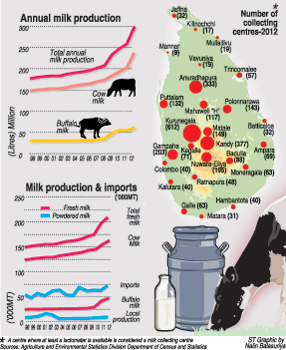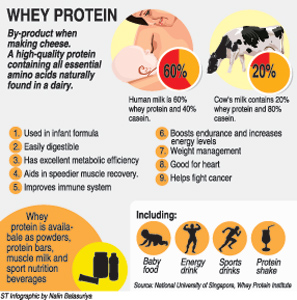News
Milk in a pickle
Three weeks after the milk crisis broke out in Sri Lanka, the confusion continued, further bemusing the people when some “experts” discussed issues totally unrelated to contamination and the Government maintained a sphinx-like silence. Thunder and fury exuded by the experts effectively curdled the milk fiasco, without casting much light on crucial issues. This was as humble mothers (who had been compelled to go back to work) and fathers rushed from shop to shop looking for milk, especially infant formula to appease their howling babies.
Here are the issues faced by the people, gathered from numerous calls and discussions the Sunday Times had this week:
- Is milk good or bad? Should people stop giving milk to their children, after two years of age?
- What is better – liquid milk or powdered milk?
- If liquid milk is better, does Sri Lanka have the capacity to meet the demand of the people?
- What are the guarantees the Government can give to assure the purity and quality of liquid milk?
- Is there Dicyandiamide (DCD) or any other contamination in milk powder? What of the harmful effects?
- Is whey protein, added to many products including infant formula, chocolates and dietary drinks for sports persons, a waste product?
- If a mother of a newborn is compelled to give milk other than breast-milk, should it not be infant formula? Is there a problem with infant formula in Sri Lanka? As all the infant formula containing whey protein seemed to be shoved off the shelves, what could desperate mothers, who were back at work, feed their babies?
First the experts bellowed about DCD contamination of milk, may be rightly so, based on a report of the Industrial Technology Institute (ITI). Next they screamed about the value of liquid milk as against powdered milk. Now they are tearing their hair off and turning the humble non-technical, non-scientific people’s world upside down by saying that “milk is not essential”.
This is while another so-called expert categorically stated on television that “whey protein is a waste product” and another expert who the previous week claimed to be the protector of the “poor children of Sri Lanka” sat on the same panel. By Thursday Cabinet spokesman Keheliya Rambukwella announced that a Cabinet Sub-Committee comprising relevant senior ministers would examine the whole milk issue and submit a report to Cabinet. The Sunday Times understands that the committee may be headed by Health Minister Maithripala Sirisena and meet tomorrow (August 19).

Public Health Inspectors checking milk products at super markets. Pic by M.A. Pushpa Kumara
Following hot on the heels of this decision, came a strong order against Fonterra Sri Lanka by the Gampaha District Court on Friday, banning the distribution, misleading advertising etc., for two weeks. The confusion among the public, however, has got confounded, and many were strident in their calls to the Government.
The Government is duty-bound by the people of this country whom they are supposed to serve to come out with the truth and the whole truth to clear the murky milk issue once and for all, many told the Sunday Times. With the humble man and woman on the street reeling, caught up in doubts and fears, more experts brought in the breast milk factor (which hopefully everyone knows is essential and vital for a newborn at least for six months and then complemented by food till the baby is over two years old).
In this web of confusion, rational and sensible people stressed the need for prompt action by the Government to guide the people along the right path. Chase away any multinational that is not conforming to the highest standards of quality, said a senior doctor, underscoring that the Government should ensure that one monopoly is not substituted for another monopoly, but phase it out and don’t drop a milk bombshell on the people, he said, a view echoed by many.
Pointing out that the milk fiasco has been politicised beyond imagination, another source was categorical that certain “saviours” of the poor were eyeing posts or even attempting to make this issue a launching pad into politics. “Is this taking on the hue of ultra-nationalism,” was the serious concern of several intellectuals who feared what the repercussions would be, if this was let loose in a country which has just seen the end of a bloody conflict that tore the very heart out of it.
Many also pointed an accusing finger at the media for running with the story without asking pertinent questions, while others wanted to know why there was no phase-out programme for powdered milk, while strengthening the liquid milk industry. The Sunday Times, meanwhile, endeavoured to answer some of the questions the people were grappling with.

Firmly debunking the view that whey protein is a “waste-product”, a senior and well-qualified nutritionist stressed that it is a by-product when making cheese. Whey protein is now used to enrich the nutritional properties of certain types of food and is an important component in food products.
Taking up milk, this nutritionist, who declined to be identified in this melee of information and misinformation, said milk is a good form of nutrition be it liquid or powdered. “Milk powder is concentrated milk and 100ml of fresh milk is equal to two tablespoons of milk powder,” according to this nutritionist, who says that a child of about six years would need 100-200ml of milk, equal to half or one cupful of milk. “This amount doesn’t necessarily have to come from milk; it can be from other milk products such as cheese and curd.”
When asked about the need for refrigeration facilities and the capacity and distribution network if people wanted to switch to liquid milk, this expert was of the view that only 65% of people in Sri Lanka have fridges. This does create a problem in keeping liquid milk for a longer period. Another suggestion is the use of buffalo and goat milk to meet the demand.
No one, however, had an answer to give mothers who have been compelled to return to work to eke out a living, amidst many hardships of transport and daily chores, what they should give their infants. The only answer was express breast-milk and leave it for the baby – whether it is practical only working mothers will know.
Testing milk for DCD and bacterium
If we find anything we will inform the Technology and Research Ministry, said Industrial Technology Institute’s Chief Executive Officer and Director, Dr. G.A.S. Premakumara, adding that more milk powder samples taken from outstation areas are also being tested for DCD and tests will continue.
Meanwhile, the Sunday Times also learns from him that long before ITI’s first test for DCD in July which found certain brands positive, the ITI has been checking Fonterra products for other parameters such as moisture, acetic acid content and insolubility index.
In July, the ITI tested for DCD in one sample each of Anchor Full Cream, Anchor 1+ both from Fonterra; Maliban Non-fat; Diamond; Highland and Pelwatte.
While the imported brands of Anchor Full Cream, Anchor 1+, Maliban and Diamond tested positive for DCD, the local brands Highland and Pelwatte were negative. Maliban which imports its milk-powder from Australia has expressed surprise that its product tested positive, as Australia has not used DCD for 100 years.
No detections of Clostridium botulinum bacteria have been made in milk products containing whey protein tested by the Medical Research Institute (MRI), said Director Dr. Anil Samaranayake, adding that tests will continue.
Fresh milk not sufficient to meet demand
Sri Lanka needs 730 million litres of fresh milk per year but the production last year (2012) was 299 million litres, said Livestock and Rural Community Development Ministry Secretary Dr. K.M.T. Kendaragama, holding out hope that by 2016 the country would be self-sufficient in milk as laid down in the Mahinda Chinthanaya.

There is a shortfall of 430 million litres per year as of now, while we are expecting a doubling of demand in the coming year which would mean that 1,400 million litres per year would be required. This would mean we only provide 40% of the required amount, he told the Sunday Times. Of the 299 million litres produced in 2012, 60 million litres were buffalo milk.
Explaining that the growth of the local fresh milk industry has been 2% per annum up to 2011, he said that last year it spiked to 16%. Two thousand cows were imported last year and their calves distributed to local farmers to better the quality and quantity of milk.
There have also been islandwide artificial insemination programmes using imported semen from Australia. Thirty new chilling centres have been established and 30 more are to be set up this year. Grass has also been imported and October 30 declared ‘Grass for Milk Awareness Day’, with free grass being given to farmers.
The “spike” in milk production, according to him, occurred due to the price of raw milk being increased from Rs. 33 to Rs. 50 under the 2011 Budget and as farms in the east have been provided collection centres.
Referring to the maintenance of quality, Dr. Kendaragama assured that two standard tests, for the fat content and ‘keeping’ quality, are performed prior to accepting milk from local dairy farmers who are expected to bring the milk to the collection centre within four hours of milking.
“All Government standards are followed. Cold chambers are maintained and even while transporting, insulated cool trucks and bowsers are used,” he said, adding that at the moment no microbiological tests are conducted at the processing plants but this technology is being developed.
Going back to the 1950s and ’60s when there was a fresh milk-drinking culture, the Secretary said with the import of cheap milk powder from various sources and no import control, people switched to imported milk powder, believing it was more convenient and better.
But fresh milk is more nutritious and economical, he said, citing the price of a litre of milk made from milk powder costing Rs.100 and liquid milk being Rs. 50.
Dealing with complaints that fresh milk is not available widely, Dr. Kendaragama said it is a slow-growing industry. It is not fair to expect door-to-door milk sales, as it is no longer considered healthy to consume raw milk and processed liquid milk is readily available in shops.
Local companies that sell liquid and powdered milk
Milco Pvt. Ltd., a semi-government organization, produces sterilized, pasteurized and both plain and flavoured UHT milk, as well as full cream and non-fat milk powder. It does not produce infant formula milk. “Our capacity to meet the demand is inadequate and a new factory will be set up in Gampaha in the next two years,” said Quality Assurance Manager Kumara Jayaratne. All its factories are ISO certified, while Milco has 76 collection centres as well as farms and chilling centres.
There are occasional complaints, fewer than five complaints, a month as the milk is not always stored in ideal conditions by sellers, he added. Nestle Lanka PLC distributes liquid flavoured milk, Milo, and Shaktigen and also powdered milk to the local market. Eighty per cent of all the milk used in its products is from Sri Lanka and the balance from the US and Fonterra New Zealand.
Its infant formula, NAN, is imported from the Netherlands, Philippines and Switzerland. They follow the worldwide Nestle safety standards. Richlife Dairies Limited has full cream, low fat and non-fat liquid milk, all locally produced. “We are an ISO certified company (2004-14001) and also have OHSAS 18001-2007 certification, said CEO Dinesh Nalliah, adding that as it does not have its own farms, there are nine collection centres island-wide, with milk being supplied by farmers who are registered with the company.
Lucky Lanka Milk Processing Company has sterilized, pasteurized and plain and flavoured UHT milk. “Our products are 100% local and we are an ISO certified company,” says CEO Keerthi Gunawardena, adding it does not have its own farms, but obtains liquid milk from seven collecting centres.Lanka Milk Foods and Cargills Ceylon PLC did not wish to divulge any information, while Pelwatte Dairy Industries was not contactable.
Milk nutritious but not essential, breast best for babies: Dr. B.J.C. Perera
Milk of any sort is a good form of nutrition, said Sri Lanka Medical Association (SLMA) President and Consultant Paediatrician, Dr. B.J.C. Perera, pointing out, however, that it is “not an essential form of nutrition”. Breast milk, though, he stressed is an essential form of nutrition. It is the “absolute elixir of life” for babies.When asked about the controversy raging in the country, Dr. Perera said “pure” powdered milk made from cow’s milk provides good components of nutrition based on the amount that is consumed by a person.
Referring to the dicyandiamide (DCD) contamination issue, he said DCD is a nitrogen compound. The quality of milk is assessed by scientific methods which measure nitrogen. That value is then equated to the protein content. That is the reason why melamine was added to milk a few years ago to fraudulently increase the nitrogen content.
(Several years ago, there was a major scandal in the powdered milk industry, when a Chinese company was found to have added melamine to increase the protein content.)
However, no one is suggesting that DCD was wilfully added to milk, Dr. Perera said, pointing out that the DCD contamination in some batches of powdered milk had come about due to this chemical being in the soil and grass and being ingested by cows.
So far, there have been no “undesirable effects” on humans due to DCD, but there may be “potential hazards”, he said, adding that New Zealand has stopped spraying DCD and there is no reason to have this substance in milk once the already-sprayed DCD has been biologically degraded.
Dealing with whey protein, the SLMA President was categorical that it is not a waste product. It is, in essence, a by-product which is the soluble fraction extracted from milk when making cheese. Whey protein which contains lactalbumin and globulin and also minerals, forms 60% of the protein content of breast milk, he said, adding that cow’s milk has just 20%. Whey protein is added to certain milk products and infant formula and is used as a dietary supplement especially for sports persons.
“There is, of course, no scientific data which indicate that an increased intake of protein would lead to enhanced performance,” he said.
Recently there has been evidence of contamination of whey protein with Clostridium botulinum, an anaerobic organism which thrives in an atmosphere devoid of oxygen. The toxin produced by this organism is poisonous to the nervous system and some cases have been reported in the world where the toxin has caused major neurological issues, said the SLMA President. “The problem is not with whey protein but with whey protein that is contaminated with Clostridium botulinum.”
Pointing out that the “ideal” would be liquid milk as against powdered milk, when the Sunday Times queried about the quality of liquid milk, this Paediatrician said that quality should be ensured by the relevant authorities. As far as he knows quality is measured by specific gravity, he said, cautioning however, that it can be changed by adding things to it.
“Yes,” conceded Dr. Perera, pointing out that when consuming liquid milk, if there is erratic refrigeration and the milk is kept out of the fridge for long periods, there could be spoilage.
Underscoring the fact that for babies, breast milk is the best, this Paediatrician said that even if the mother has to return to work early after the birth of a baby, breast milk can be expressed and fed to the baby. Breast milk can be kept at room temperature for 24 hours, according to him, in the door of the fridge for 24 hours and in the freezer for as long as three months.
If a mother is compelled to substitute formula feeding for the breast, what is in the market is infant formula in powdered form, he explained, adding that in developed countries there are specially prepared liquid infant milk in cartons available in the market.
Sterilised, pasteurised and UHT milk
Raw or liquid milk comes to the consumer as sterilised milk, pasteurised milk or UHT milk (which has undergone ultra-heat treatment).
In-depth research on the web by the Sunday Times team found:
Sterilised milk is obtained by heating raw milk at a temperature ranging from 114-120C in a sealed container to kill all micro-organisms. After that it is generally stored in a corked glass bottle, which can be kept at room temperature prior to opening.
Pasteurized or ESL (Extended Shelf Life) milk is produced by heating raw milk to a temperature of 72C for 15 seconds, as any temperature closer to boiling point would cause the milk to curdle. Heated and then immediately chilled, this milk is packed in sterile containers. This process kills only the harmful bacteria in milk and renders all others dormant. This milk must be stored under 4C to keep the dormancy of these micro-organisms.
UHT milk is produced by heating the milk at a temperature of 140C for two seconds and packing it in a sterile container immediately after heating. This can be stored at room temperature for about nine months, if the seal is unbroken.
Follow @timesonlinelk
comments powered by Disqus

